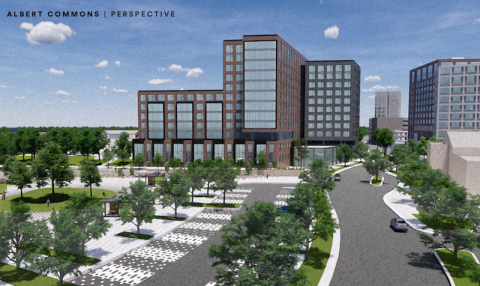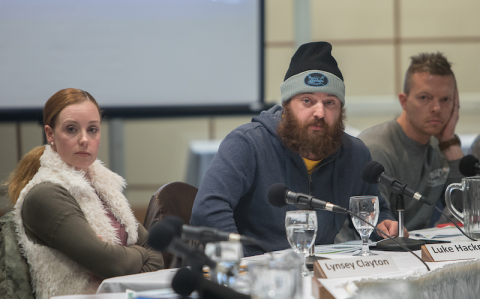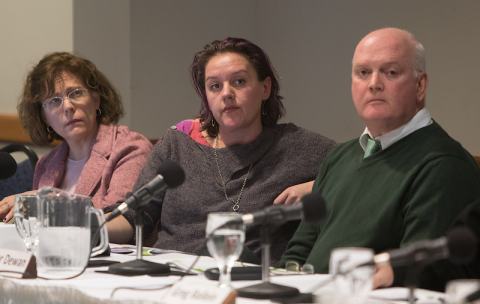You are on eastlansinginfo.org, ELi's old domain, which is now an archive of news (as of early April, 2020). If you are looking for the latest news, go to eastlansinginfo.news and update your bookmarks accordingly!
You are on eastlansinginfo.org, ELi's old domain, which is now an archive of news (as of early April, 2020). If you are looking for the latest news, go to eastlansinginfo.news and update your bookmarks accordingly!

Above: DDA Chair Peter Dewan (center) at the meeting. Photos by Raymond Holt.
Five elected officials and seven appointed community members sat together at long tables facing the public in the banquet hall at the Hannah Community Center last night for the first-ever joint meeting of the East Lansing City Council and Downtown Development Authority.
The Downtown Development Authority (DDA) requested this meeting of the two bodies to try to reach agreement about what type of development project will be supported on the Evergreen Avenue properties that the DDA owns. The publicly-owned properties are saddled with about $5.5 million in debt, and that debt is set to come due in a few years.
Both bodies must approve a project on this land, but they were deeply divided on the last proposal, put forward by Paul Vlahakis and Royal Properties of Illinois.
In yesterday’s meeting, which extended well over the one-hour scheduled time, each member of both bodies was given time to express their priority for redevelopment of the properties.
The next step will happen at the meeting of the DDA at noon tomorrow, when the DDA has been planning to vote on issuance of a Request for Proposals (RFP) for these properties. The RFP would constitute a formal invitation to all developers to pitch ideas for the properties.

Near the start of the meeting, East Lansing Planning Director Tom Fehrenbach (above) gave an introductory slide presentation about the Evergreen Avenue properties, the current zoning and Master Plan at this location, the outstanding debt of $5.5 million on these properties, choices for how to fund needed public infrastructure in this area (either by the City or using Tax Increment Financing (TIF) tied to an approved project), and two options for how to move forward.
The options Fehrenbach identified were: (1) release an RFP for the DDA-owned properties or (2) begin negotiations for an exclusive Pre-Development Agreement with developers DRW Convexity to allow them to seek approval of a new project for the Evergreen properties.
The second option would follow the model of the exclusive agreement that the DDA signed with Vlahakis and Royal Properties in December 2018.
Request for exclusive contract from DRW Convexity:
DRW Convexity’s lawyer, David Pierson, summarized their "Albert Commons" plan during the public comment period at the beginning of the joint meeting, as he did at the beginning of the DDA’s work session last week. It calls chiefly for an 80-120-foot-tall building of "market-rate" rental apartments on the DDA properties.

Pierson’s argument for why City officials should negotiate with his clients rather than giving multiple developers a chance to respond to an RFP is based on several offers that only DRW Convexity can make.
First, DRW Convexity proposes to eliminate all of the DDA’s debt on the Evergreen properties by paying $3 million for the DDA properties and financing the additional $2.5 million by increasing the TIF on DRW Convexity’s two large buildings on Grand River Avenue on which construction is already underway (The Abbot at the corner and The Graduate hotel next to Peoples Church).
That TIF could be increased, additionally, to finance more of the public infrastructure needed in the area. The size of a TIF depends on the increase in the value of property as a result of a new development, and including these two big buildings (both due to be complete next year) would allow for a bigger TIF than one based on a project from a development built only on the land owned by the DDA. That gives the City TIF leverage it can’t get without DRW Convexity.
Second, DRW Convexity proposes to donate to the City the land that (only) they own at 341 Evergreen Avenue between the DDA-owned land and Valley Court Park for an extension of the park, expanding the park by more than an acre. That would mean DRW Convexity cancelling its plans for a 99-unit building, known as “Building C.”

Building C, unanimously recommended by the Planning Commission on November 13, includes 74 apartments for tenants who qualify for low-and moderate-income housing. These units are designed to satisfy the 25 percent housing diversity requirement for all three of the Convexity buildings in the Park District.
Pierson confirmed to Mayor Pro Tem Aaron Stephens last night that donating the land as City parkland would mean that the affordable housing component of their Park District development would be eliminated.
The current plan for Building C is supported by a group of homeowners in the Oakwood neighborhood to the north, but considered unacceptable by Peoples Church to the south because of parking concerns. (Both groups indicated support for issuance of an RFP, but both letters also predated the new pitch from DRW Convexity.)
The third advantage DRW Convexity seems to have is that the disruption caused by construction could be shortened if DRW Convexity can get a project approved quickly and continue working with the construction firm that currently is working at the nearby site.
Priorities of Council and DDA members for these properties
Mayor Ruth Beier, who chaired the joint meeting, said her goal was to allow everyone time to say what they wanted to see on the DDA properties.

Beier (above) said that the challenges of the Park District and the properties bought by the DDA was the reason she first ran for City Council six years ago. She described the original intent to buy the land as asset and work it in with other blighted properties to build something beautiful.
More than ten years later, Beier said, the Evergreen Avenue asset has become an albatross. Now, the $5.5 million public debt has become a problem to solve rather than an investment to promote growth.
The other change during this time, Beier noted, is the building of two large student-attracting apartment buildings (The Landmark and The Abbot) nearby, plus another one on Bogue Street (The Hub). We are probably at our limit of student housing, she said, so she is not interested in another tall student-attracting apartment building on Evergreen Avenue.
Mayor Pro Tem Stephens wanted to send a clear message to both the DDA and prospective developers about what the Council wants here. He suggested that the Council discuss what zoning it wants at this location and then stick with that decision. Developers would then know that a project within these parameters would be well-received.
Council member Mark Meadows said he agreed with the Mayor that another apartment building here doesn’t fit the bill. He said the City needs “a breather” to see how the Center City and Park District developments impact the downtown, and that the timing of releasing an RFP and evaluating responses would allow this to happen.
Meadows estimated that Council approval for a project resulting from this process probably would not happen for at least a year. Meadows also had suggestions for the RFP: don’t require retail on the first floor, strengthen green building design and other environmental criteria, and require parking to accommodate needs at this end of downtown.
Peter Dewan, chair of the DDA, said he has regarded the decision about this property as more significantly a land use (what to build) question than a debt (how to pay for it) question, although he recognizes that the debt is an issue. He urged that people be visionary.
The landscape of our downtown has changed, Dewan said, and “we have an opportunity to do something special in this area of the city – this is a once-in-a-lifetime opportunity.” He sees the expansion of the park, as DRW Convexity proposes, as transformational.
Other DDA members followed, expressing their views.
Below: DDA members Lynsey Clayton, Luke Hackney, and Mike Krueger.

Lynsey Clayton agreed with Stephens that it is important to send a clear message to developers about what maximum height would be acceptable to Council.
Greg Ballein said that, in terms of building on the Evergreen properties’ site, “to keep it under a certain height, that there’s gonna have to be some compromises on our part and we might not get what we really want out of it.” He does not want to require first-floor retail, as he thinks it would fail at this location, and eliminating tall first-floor retail would allow for a larger number of profitable residential units or some other use. He also urged that a project contain adequate parking.
Luke Hackney said he agreed with Ballein’s sentiments and said the outstanding principal on the debt was his primary concern.
Mike Krueger advocated not making the RFP too detailed so that developers can propose what they know the market will bear. Like others, he expressed concern about inadequate parking. He also said he would favor leaving open the possibility of conditionally rezoning the properties to be taller, if a project makes sense.
Jill Rhode said, as a municipal finance professional, she will continue to emphasize getting the highest price for the properties. Eliminating the DDA’s debt is her priority.
Below: DDA members Jill Rhode and Eric Sudol and Planning Director Tom Fehrenbach.

Eric Sudol concurred with Rhode that the debt is his biggest concern. Royal Vlahakis had said they would pay the full amount of the debt for the property, and Sudol thought their project should have been approved.
Clayton asked the three Council members who participated in unanimous negative vote on the Royal Vlahakis proposal to explain the reasons for their opposition. Both Meadows and Beier said they did not support the project once it changed from featuring a movie complex with automated parking.
“I’m not willing to put a high-rise student apartment there to get rid of the debt,” Beier said. “That’s why I voted ‘no’.”
Stephens said he preferred an RFP process to an exclusive deal, and wanted a project that nearby neighborhoods were comfortable with.
Below: Council members Lisa Babcock and Jessy Gregg and DDA Chair Peter Dewan.

Council member Lisa Babcock suggested that an appraisal of the DDA properties be done soon. City Manager George Lahanas said this could be done, based on an estimated cost of $10,000 to $15,000.
Council member Jessy Gregg said her vision for this area is close to what DRW Convexity is now proposing, although she recognized that many people now favor releasing an RFP. She said it is unlikely that a project on this site would fully pay for the DDA debt, given economic realities.
Gregg also expressed reservations about overusing TIFs, arguing that high level of TIFs is driving up and then robbing dedicated millages.
The DDA’s follow-up meeting starts at noon tomorrow in Conference Room A of City Hall.
Correction, Nov. 22: After publication, we amended that Ballein “expressed concerns about whether a project could be viable if its height is too limited” to quoting Ballein directly: “to keep it under a certain height, that there’s gonna have to be some compromises on our part and we might not get what we really want out of it.” To his comment that eliminating tall first-floor retail would allow for a larger number of profitable residential units, we added the words “or other use.” We also added that Hackney said the outstanding principal on the debt was his primary concern.
Appreciate ELi's reporting for this community? Make a tax-deductible contribution today and we will DOUBLE that support with matching dollars! We need your help today to keep our work going in 2020!
eastlansinginfo.org © 2013-2020 East Lansing Info